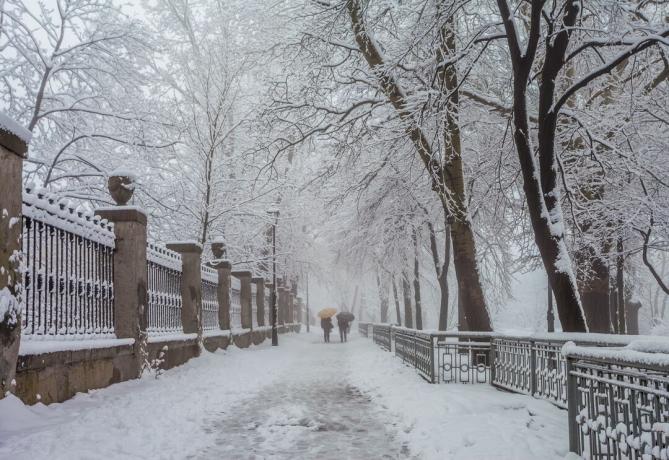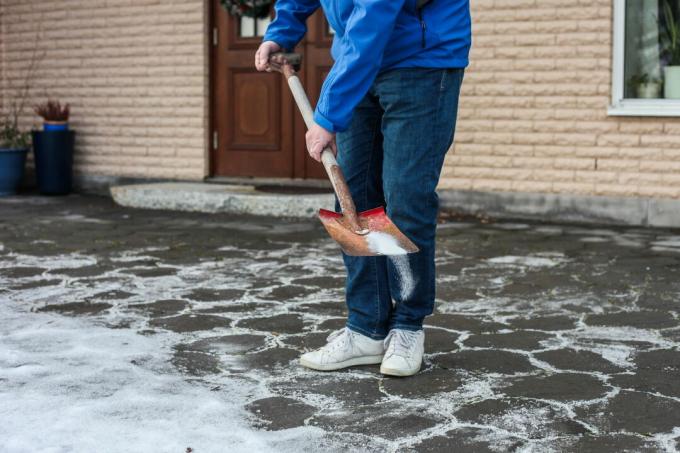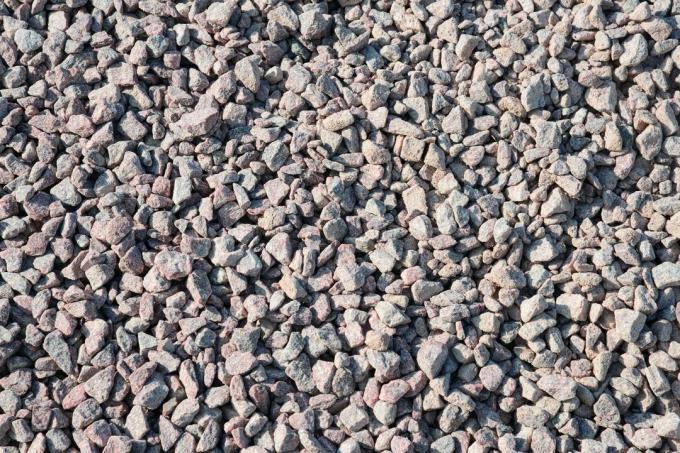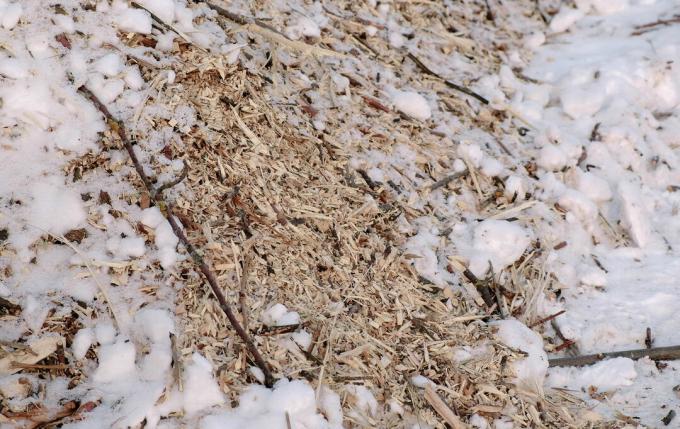Road salt prevents slippery roads and sidewalks from becoming a danger in winter. But what types of grit are there and what are their advantages and disadvantages? We compare road salt, lava grit and Co.

Getting safely from A to B in winter is sometimes not that easy. To prevent accidents, there is an obligation to clear and spread in Germany: Homeowners and renters must ensure that adjacent public sidewalks are clear of snow and stay ice. But while the snow can be removed with pure muscle power, many quickly resort to road salt, especially on frozen ground. However, this has a reputation for being extremely harmful to the environment. But is this rumor true and is there perhaps even an environmentally friendly alternative? We will tell you here which grit is best suited for private use.
What kind of litter is there?
Road salt is probably the most well-known agent used in the fight against snow and ice in winter. But in addition to the well-known road salt, there are other types of grit in winter that help with snow and ice: so-called while deadening agents do not melt the ice, they do increase grip and therefore decrease it Slipping. Grit, sand or ash are well-known as grit in winter. But sawdust, lava granules or fir branches can also be suitable for spreading in winter. In addition, mixtures of salt and various deadening agents are offered, which promise a quick and permanent reduction in slippage.
Advantages and disadvantages of road salt and co
Many people are looking for an environmentally friendly grit that is an alternative to road salt, which is considered to be harmful to the environment. Sand, gravel and co cannot melt the ice, but they ensure that the risk of slipping on the sidewalk is reduced and you can walk home safely. In addition, grit without salt is significantly more environmentally friendly, as it does not seep into the ground and thus does not disturb the soil balance. You can now find out the advantages and disadvantages of the alternatives in detail.

1. road salt
Spreading salt is still one of the most well-known ways of removing snow and ice from sidewalks in winter. In fact, it's the only method that actually melts the ice—putting salt on ice scattered, the melting point decreases, which is why it begins to thaw even at temperatures below zero. However, the salt has some disadvantages when spreading: The grit gets into the ground with the seepage water and accumulates there and in the groundwater. Many plants, including street trees, cannot tolerate the increased salt content in the soil and water and die. Spreading salt in winter thus pollutes the environment. Many animals also do not tolerate road salt because it irritates their paws and can lead to inflammation. Road salt can even have negative consequences for cars: Aluminum components in particular oxidize more quickly when they come into contact with road salt, and rust formation is also accelerated. For these reasons, many municipalities have already banned the use of road salt on public roads or made recommendations for other road salt.
2. Gravel and grit as grit
Gravel or grit are already a widely used grit for the winter in many communities and can be purchased inexpensively in many hardware stores. The sharp-edged surface guarantees a secure grip even on icy ground. Both variants are significantly more environmentally friendly than road salt. If you opt for a regional product without heavy metal contamination, the sidewalk gritting has almost no negative effect on the soil and groundwater. In addition, gravel and grit are considered to be particularly sustainable, since the grit can be swept up after the last frost and reused next year. However, it is only suitable for pet owners to a limited extent: with their sharp edges, gravel and grit can injure the sensitive paws of four-legged friends. Many homeowners are also not impressed by the environmentally friendly alternative, because the sharp stones like to get stuck in shoe soles and can then scratch the floor in the house.

3. Lava as grit
Lava grit has become increasingly popular lately. No wonder, after all it has numerous advantages: Similar to gravel and grit, it reliably ensures slip resistance hardly any negative effects on the environment if it comes from regional mining and can be swept up again after the winter will. In addition, the lava granulate has another special feature: Its grains do not have any sharp corners, but are slightly rounded. This not only protects animal paws, but also avoids scratches in the parquet. In addition, porous lava rock absorbs some of the moisture, reducing the risk of slipping. The Eifel lava grit is particularly recommended. This not only scores with its regional degradation, but does not necessarily have to be removed in spring. Indeed, the porous material has similar expanded clay a soil-improving effect, which gardeners in particular can take advantage of.
4. Sand as grit
Alongside road salt, sand is one of the most commonly used materials for spreading in winter. The grit is particularly attractive for many because of its low price. In addition, you have the option of sweeping up and reusing the sand after winter. If that's too much work for you, you can put the remaining grit in the without a guilty conscience Sweep the joints of the garden path or into the nearest bed, because sand is not good for soil health disturbing. However, fine-grained grit is not quite as slip-resistant in winter as coarse-grained materials and therefore has to be cleaned more often be sprinkled afterwards - you should therefore always make sure to add particularly coarse-grained sand, for example gravel sand use. Sand often leads to a higher degree of soiling of shoes and clothing, as mud quickly forms if it is permanently wet.

5. Ash as grit
Due to a lack of alternatives, ash was a popular grit, especially during the war. As a waste product that often occurs in houses with a chimney, the ash can be put to good use. In addition, it can later be swept into adjacent beds for disposal; because you can ash as fertilizer use. However, the high pH value of the ash must be taken into account - this can also have a negative effect on adjacent beds and plants if used regularly. In addition, not every ash is suitable as a grit: While pure wood ash contains almost no toxins, it can Coal ash or ash obtained from the burning of painted wooden parts can be polluted and thus the environment damage. In addition, ash has the disadvantage that, due to its fine grain size, it can be walked on quickly and therefore has to be sprinkled on frequently in order to have an anti-slip effect. Many are also bothered by the fact that ash visibly soils the sidewalk and shoes.
6. Sawdust and fir branches as grit
If you are looking for an environmentally friendly grit, you will quickly come across sawdust or fir branches. Both have the advantage of being easily swept up during thaws and subsequently composted can become. Nevertheless, the use of woodcuts as grit should be treated with caution. Since sawdust in particular tends to soak up water and then no longer has any anti-slip effect, this material is only suitable to a limited extent for scattering snow. With fir branches, you also have to make sure that there are no tripping hazards, for example from protruding branches. In addition, wood chips and fir branches are not recognized as grit in many communities - if an accident occurs, the homeowner may have to pay for the damage.

The best spreading material for the winter
Sustainable and yet non-slip - for many, this is what the perfect grit for the winter looks like. The lava grit performs particularly well in these criteria: thanks to its coarse grain size, it provides sufficient protection against black ice and is therefore well suited for gritting in winter. In addition, it is considered to be particularly environmentally friendly because it can be reused or incorporated into surrounding beds as a soil-improving measure. Sand is also suitable as an environmentally friendly alternative to road salt, which scores particularly well with its low price. However, you should pay attention to a particularly coarse grain size and regular sprinkling in order to obtain sufficient protection against slippery surfaces. Spreading salt in winter, on the other hand, does not prove to be environmentally friendly - because the grit has a high Soil and environmental pollution arises, this type of pavement spreading should only be used in an emergency will.
Tip: If you are already looking for sustainable grit in the hardware store, you should look out for the "Blue Angel". The independent environmental label of the Federal Government identifies particularly environmentally friendly grit.



